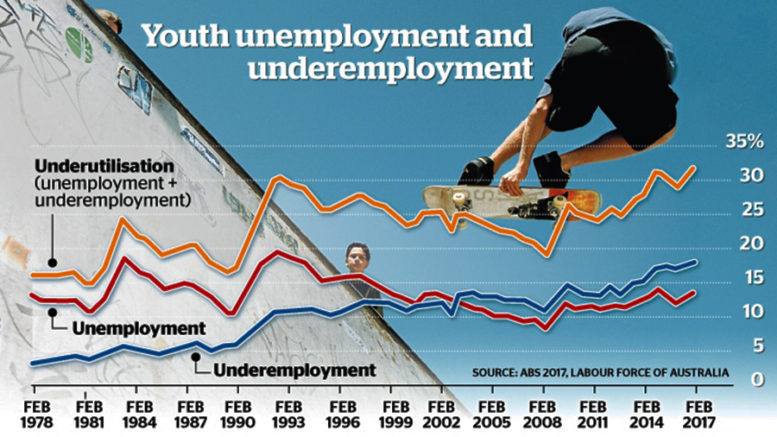Contributed by Adam Carlton
The Brotherhood of St Laurence has just released a report that has found youth unemployment in Australia is the highest it has been since it started to be counted by the government 40 years ago.
In February this year, it stood at 18 percent of 15-24 year old Australians being out of a decent and permanent job. This in on top of the 13.5 percent officially unemployed.
But as all official statistics on unemployment and underemployment, the true numbers are seriously underestimated. Based on available data that applies for the general population, the true figure is at least double.
This is a national disgrace and finding jobs and a future for our youth should be a considered a national priority. Instead, Australia’s young unemployed and underemployed are being punished through Centrelink, by being made to wait longer for payments and increasingly imposing other restrictions. They are being used up as cheap labour through work for the dole schemes and little protection from unscrupulous employers. There is documented evidence, which shows that sometimes they are put at risk by being forced to do work they are not trained to do.
The Brotherhood report says that underemployment has “become an entrenched feature of the youth labour market”, while the youth unemployment rate…”
The analysis draws on data from the Australian Bureau of Statistics (ABS), and the Household, Income and Labour Dynamics in Australia (HILDA) Survey and shows that in the past 15 years the average gap between the working hours of underemployed young people and their desired hours has widened. This means that this is a systemic problem that cannot be blamed on the individual. Improve the situation. It is Australia’s already cash starved young workers who will be most affected by this. By taking this retrograde step, the Australian government has shown that it does not care.
A big part of the problem has been the decline of traditional industries and the rise of the hospitality industry that employs a large part of its workforce on a casual basis. Jobs within the hospitality industry seem to be growing in popularity in many different countries. Not that this is such a bad thing. It does seem to be a rite of passage for many younger people to have at least one job in this industry as it can help them on their way in their later careers – and by using government funded courses in melbourne, they can improve their skills and gain valuable experience which could be highly valued by future employers. There are plenty of places that advertise for jobs in the hospitality industry, including Silven Recruitment, (https://silven.co.uk/jobs/). People who are in current need of a new job should have a look at their website to see if there is anything that they like the look of. However, it is becoming increasingly hard for people to find employment. Only through government initiative to set in stone minimum working hours, build new industries and an extensive training program to meet the real needs, can the problem be turned around.
Young Australians fare being put in a situation where, they are finding it very difficult to get a foothold in the labour market that will provide them with opportunities to build for the future. The prospects for future work as this generation gets older are not looking good.
James Brown a 19-year old describes what it’s like being under employed. “I’ve been paying two thirds of my weekly income on rent… it’s difficult but really I’ve learnt to kind of live with it…I have no savings, let alone having a beer on a Friday night.” James works 10-20 hours per week in retail on the Gold Coast. He says he applies for 30 full-time jobs per month and gets nowhere.
Australia’s most famous working class man, singer Jimmy Barnes, has joined the campaign to help.
Barnes, who grew up in Adelaide’s manufacturing heartland of Elizabeth, has written a column for the Brotherhood of St Laurence calling for changes to help young people.
“From parents to governments, we owe it to the next generation to do better on this, don’t we?” Barnes wrote.
As a 16-year-old in 1973, Barnes says he didn’t have to look very hard to get an apprenticeship as a moulder on the South Australian Railways.
“That job I did is now long gone, and if it exists anywhere is being done somewhere offshore,” he said.
“The world of work has become that much more complicated. Yet too often we keep blaming the victims of these huge economic changes rather than addressing the challenge of helping people into working life.”


Be the first to comment on "Youth underemployment is the highest it’s been in 40 years"